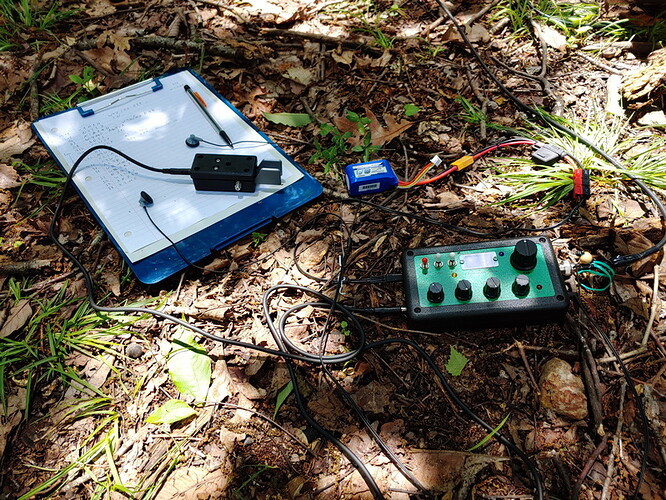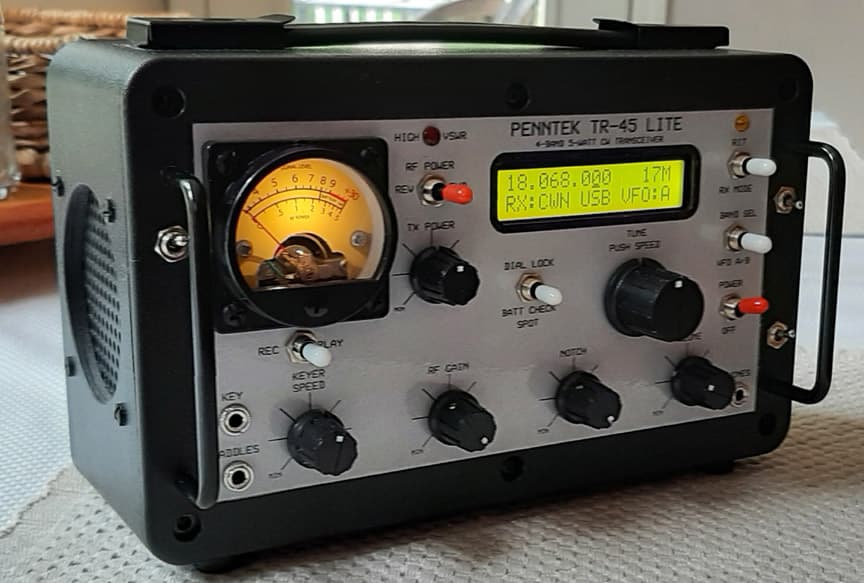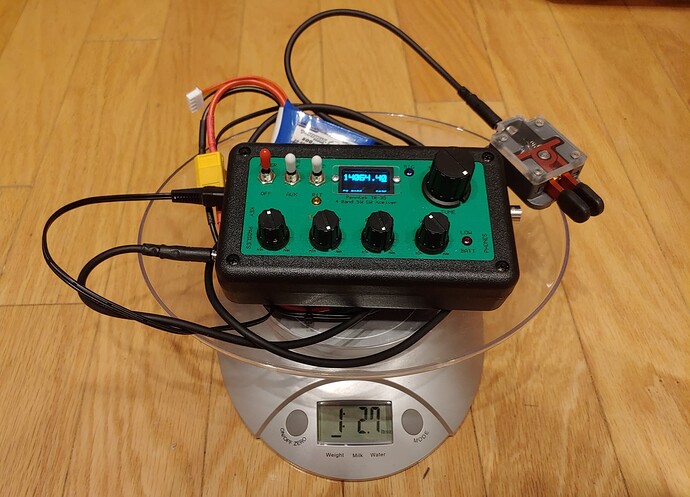I came across this qrp trx unknown to me. Looks interesting.
73 Chris
I did not know him yet… interesting with 30m and 17m
…if I didn’t have my QCX mini… that would be something…
73 Armin
i had my Penntek TR-35 QRP rig on the air for a few hours operating Pedestrian Mobile a few weeks ago using a 10 foot whip and a drag wire on 14061 kHz.
i worked 9 stations:
W7JCF John WA,
WB9HFK Mark IL,
n9ru ? Lost,
WA9PWP Paul WI, (he also heard me on 17M),
AB5X Bob TX,
K5MUG Cray TX,
WN9U Gary WI,
WB4LAL Ike AL,
W1PID Jim NH ,
AF8E John OH,
My ERP was around 3W.
This operation was a little like my KX1 operation on Pikes Peak,
See the picture of me standing next to the big 5 foot Oshkosh snow blowers holding the KX1. The TR-35 is similar but it has no built in key or Tuner. See http://www.qrz.com/db/w0rw/
i set the TR-35 on 14061.00 (the display is a bit hard to see in bright sunlight) and i set the “Lock” to keep it there. i used my old Whiterook
i used my regular 10 foot, center loaded whip, and a drag wire that connected to my Elecraft T1 tuner. The tuner then went to the TR35.
Got a SWL report from N6CC said he just barely heard me in SF, CA.
Another SWL report from Bob K2YGM who is in FL.
He saw my spot and used his iPhone and set it up for getting WEBSDR. Using the Washington DC SDR of NA5B, he put in 14061 and heard me calling CQ.
My signal was about a 339 and he copied many of the stations who worked me.
The RBN’s that copied me were coast to coast, VE6, VE7 and TI7.
Here is the basic info:
The TR-35 is a QRP, 5W, 40, 30, 20, 17 Meter, Rig.
Great build, no toroid winding.
See http://www.wa3rnc.com/store/
Thanks to all the callers.
Paul w0rw
Colorado
This is my current HF summit rig. I think it’s very good. I have used it on 14 activations since building the kit version about three months ago.
Sensitive receiver. Convenient controls. Low current draw – confirmed mine meets or exceeds the specs on power in/out. Lately I am running it from a 0.8 A-h 3S LiPo battery weighing 85 g.
The display is hard to read in full sun but I solve that by sitting with the sun to my left and the rig lying in my shadow to the right. The latest firmware has an inverted video mode that’s supposed to remedy that.
A few more points about my experience with the WA3RNC TR-35 since it is a recent introduction to the market and it appears that few in the SOTA community are acquainted with it. Being a CW-only rig, it won’t be for everyone, but I am finding it well suited to our application.
First, it’s been totally reliable across the 3 months I’ve had it, encompassing 15 summit activations. I consider that to be worth quite a bit, given the nature of what we’re doing.
The specified weight is 10.6 oz = 0.662 lb = 300.3 g. Mine is 10.9 oz = 309 g on an inexpensive scale. There is no internal battery nor integrated antenna tuner.
This choice of bands that the TR-35 supports, 40, 30, 20 and 17 m, gives it an edge, for my purposes, over the current-production 4-band MountainTopper which supports 80, 40, 30 and 20 m. The additional 3 oz that the TR-35 weighs over the Mtr4b constitutes 0.1 percent of the usual weight of this hiker on the hoof.
Having a VFO knob is handy for scanning around to find a clear operating frequency, or just checking for signs of life on a given band. The volume knob is nice too. I use the RF gain knob occasionally. The knobs for keyer speed and power output I seldom touch, but they work as expected. The controls protrude more than some offerings in the ultra-compact rig genre. I pack the rig in a small, stiff cardboard box with foam pieces cut to fit around the rig body and controls.
Audio quality is excellent, including in the SSB-receive-only mode (with which my kids enjoy using this rig for SWL at home, incidentally). Audio output is more than adequate for the several types of headphones I’ve tried it with. No need for amplified phones. I’ve never had to turn the volume higher than about 2/3 its range. There is no internal speaker.
The receiver seems to be every bit as sensitive, in terms of on-air performance, as my Kenwood TS-590SG. I say this based on connecting the rigs to the same antennas through a two-port switch and alternating between them while listening to various weak signals. The narrow CW filter in the TR-35 is not the granite obelisk of the TS-590SG with its modern DSP IF filtering. But it is still quite good and I haven’t had any trouble with “adjacent channel” QRM when operating.
The receiver has AGC and it works well. The attack response is not quite the instantaneous attenuation that one takes for granted in modern, mainstream rigs. A very strong signal following a period of weak signals can cause the audio to be uncomfortably loud for a fraction of a second before the AGC brings it down. This doesn’t generally happen often and I mitigate it by keeping the volume and/or RF gain turned down just a bit on 40 m, where the real blow-torch signals are most likely to appear out of the blue. The AGC recovery seems suitably fast for SOTA-style operation – weak signals following strong ones are readily heard.
The rig only supports full break-in. The RX-TX switching is relay-free and therefore silent. As heard through the headphones, the transition is clean. I had never operated with full break-in when I got this rig. Initially, I found it a distraction when sending and wished for a semi-break-in option. However, I soon adapted and have come to appreciate it.
There is no SWR meter built into the rig. Given my choice of antenna, I don’t need one on summit, assuming I remember set the dipole links correctly for the band I’m on. I can generally tell whether I’ve done so by paying attention to the noise floor as I switch between adjacent bands. On a couple of occasions, I have transmitted into a high VSWR due to mis-configuring the links. The rig suffered no damage.
As with most rigs, the S-meter is not calibrated to the standard reference of S9 equals -73 dBm. That’s because there is no S-meter! Instead, there is a blue LED with brightness in direct relation to received signal strength. For the “S” in my outgoing RST reports I just give a subjective number based on how strongly the station is heard relative to the noise floor or other signals, or, if I happen to be watching the rig, whether I detect any glow of the LED.
Power output is adjustable with a knob. Perhaps this could be useful if trying to maximize battery life or just see what you can do with 0.5 W. I have only operated it with the power at maximum. The rig has a protection circuit which folds back the output power in the event of an over-temperature condition. This has never engaged to my knowledge. The designer says the fold-back would happen after 10 to 15 seconds of key-down transmission at full power, not under normal operation.
At a loaded supply voltage of 13.4 V, transmitting into a dummy load, with the power at max, I measured power output at 7.5, 8.5, 7.0 and 6.0 W on 40, 30, 20 and 17 m, respectively. At 10.9 V input, I measured 5.5 to 7.0 W output depending on the band. If you wish to operate with no more than 5 W, you’ll need to spend a bit of time marking the front panel with the positions of the power knob that give 5 W on each band at the maximum battery voltage you intend to use.
The rig is specified to handle a wide range of supply voltage (9.5 to 14.5 V). Mine has proven happy with everything from the 14.2 V maximum I get from my LiFePo4 batteries down to 10.7 V which is the lowest I’ve run down my small 3S LiPo battery so far.
On receive, with headphones and normal listening volume, I measured the draw at 85 mA with supply at 14.2 V. On transmit, I measured the maximum draw at 1.43 A for 8.5 W output on 30 m with supply at 13.4 V under load. With the rig dialed in for 5.0 W output on each band, I measured the draw at 0.96 A to 0.99 A on 40 m through 20 m and 1.12 A on 17 m with the supply at 13.5 V.
Lately, the battery I carry on summit for this rig is a 3S LiPo drone/RC-type pack weighing 3 oz = 85 g with a rating of 0.8 A-h. I have yet to run this pack all the way down to the recommended (conservative) minimum of 10.5 V. However, I have operated as long as 80 minutes total – at full output power – with some small amount of usable charge remaining. (That 80 minutes is the time with the rig powered on and in use. It does not include time changing antenna links or otherwise taking operating breaks, during which I switch the rig off.)
The radio is available in ready-to-use form or as a kit. The kit build process is well documented and straightforward, provided you have a basic background in through-hole PCB soldering and the usual tools for the same.
All post-build adjustments are done with trimmer/pot components on the PCBs. There is no tweaking of toroid windings to peak the output power. After completing the build and initial adjustment process, the only reason I’ve had to open the case again was to tweak the pot that governs side-tone volume to better suit actual operating conditions.
VFO frequency alignment was accurate from the factory and remains so. That particular part of the alignment is apparently done on a bed-of-nails test fixture before the kit goes out the door.
Has anyone else picked up a TR-35, for summit use or otherwise?
To give an update, I’ve now used mine on 33 activations. Also, in the last couple of months it’s become my primary rig for the little bit of chasing I do.
It hasn’t failed me once and still performs as new. The tiny 3S LiPo is holding up nicely too.
Wish there were a version covering 15, 12 and 10 m. It’s light enough I could see carrying two on all but the most strenuous hikes for coverage of 40 through 10 m.
I was going to suggest the TR-45L but it’s not the same size and it only goes up to 17m anyway! ![]()
Do you also own a Mountain Topper? If yes, how do they compare?
No. Would like to try it though. If I get a chance to borrow one, I’ll update with a comparison.
For some, myself included, the band coverage (80 m in the Mtr4b versus 17 m in the TR-35) would outweigh minor differences in other respects.
My TR-35 now has 43 summit activations on the odometer and still runs like a champ. I have no incentive to promote it – just surprised that so few are using it for SOTA.
The only other QRP HF rig I myself am considering as an alternative to this one for SOTA is the KX2 – and it’s obviously in a different class on functionality and price. The Mtr4b and the QMX, for all of their good points, are not particularly of interest to me due to lack of 17 m coverage and narrower range of input voltage.
(For those not conversant in obscure units of mass, 1 lb 2.7 oz = 530 g.)
I am interested in getting a TR-35.
I’ve tried e-mailing the address on the website to enquire about overseas shipping from both my home address and work e-mail address (in case home was getting spam filtered or something) and not had a response.
If anyone has any suggestions about how to get in touch and give them some money I’d be grateful ![]()
I just took a look at the seller’s site and noticed this:
European Union Shipping Issues
Shipments to Europe are problematic because our products have not been tested for the addition of the “CE” label as is required for the European Union countries. Even though amateur radio equipment is largely exempt from the EU “RED” testing requirements, it seems that the “CE” marking is still required. This “CE” testing is very expensive. Based on the number of inquiries we get from Europe, we would never come close to recovering these expenses. We will not simply just add the “CE” mark without the required testing, as is common with Chinese products. However, it appears that the “CE” mark might not be required on kits because after all they a collection of parts and could not be tested for “CE” without being assembled. This might place the responsibility for compliance on the builder instead of with Penntek. Shipping kits only (and not wired units) might prevent the possibility of having the radio confiscated by European Customs for the missing “CE” mark. We welcome any thoughts and comments on this issue.
For what it’s worth, in my previous communications with the designer/seller, his protocol seems to be to give no response if his answer to your question is, essentially, “no.” On the other hand, when I have made requests for a missing kit part and guidance on assembly, he was prompt to reply and entirely helpful.
Thanks - I hadn’t spotted that note before on the main page. I did enquire about an assembled unit. I’ll try requesting a kit and see if that elicits a response!
Amateur radio kits are CE exempt.
“For the purposes of point (c) of the first subparagraph, kits of components to be assembled by radio amateurs and equipment made available on the market and modified by and for the use of radio amateurs are not regarded as equipment made available on the market.”
Perfectly straightforward.
Good way to generate a poor impression of his business.
I have the predecessor TR-25 and it’s a nice radio and an excellent kit (well documented and packaged). My only complaint is that the OLED display is hard to read in sunlight.
Ooh, how do you like that key?
Very much. And bonus points to BaMaTech for accommodating my request for reverse wiring: dit on the right, dah on the left.
By the way, I have a TR-35 and I love it. The problem is it gets edged out by the KX2 and KX1 since they have built in tuners.


